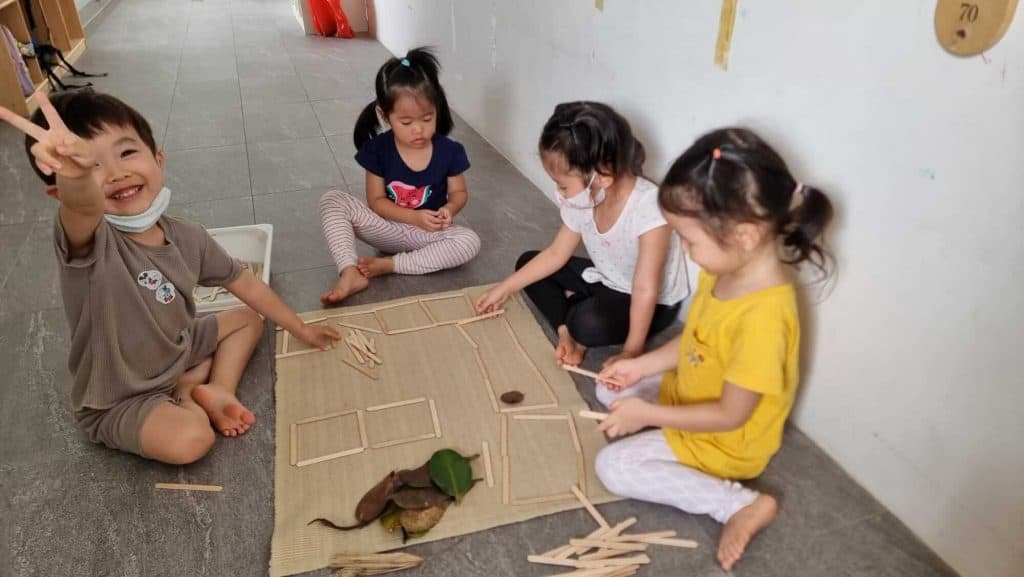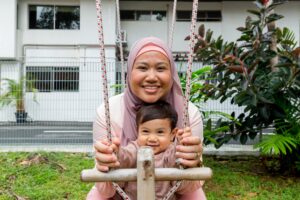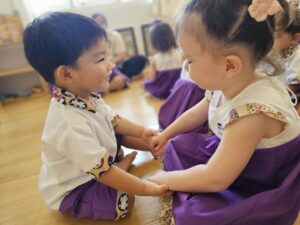4 Beautiful Locations Islandwide
Play is an important aspect in children’s learning development. When children play, it gives them many different ways and opportunities to learn through play. Information is usually best retained when play experiences are fun and spontaneous.
“Play is the work of the child”
– Dr Maria Montessori

Here at House on the Hill, we want to cultivate and explore this natural creativity and engagement further. Therefore, we are excited to introduce Loose Parts Play, together with gardening and exploration of nature-themed projects as part of our afternoon activities curriculum from 2023! Using the outdoor spaces as our play areas, the children will have numerous opportunities to explore, discover and learn in, about and through the outdoors.
The freedom to play with spontaneous ideas and creation using a collection of small objects provides the children with opportunities to make, build, experiment and invent. Loose parts materials can be used in combination, redesigned, pulled apart or put back together, carried around, manipulated, put into patterns or used as visual representations for children’s imaginations. Loose parts also invite children to explore and discover, imagine and create, enquire and experiment, play and tinker about as they build on their developmental skills in a supportive learning environment. The material in itself has limitless use in the world of the child’s creation.
At House on the Hill, our loose parts play is about guiding the children to make connections to their daily experiences. We allow the children to recreate these thoughts, ideas and feelings by documenting them using the loose parts material to make their experiences visual and concrete. With our recent trip to the zoo, the children recreated their zoo trip experience using leaves and pebbles from our garden, plus our collection of toilet paper core and ice-cream sticks.
How do we include this in our play environment at school?
Here is an example of the children’s play experiences after they took a school trip to the zoo:

This group of children explored with toilet paper cores, leaves and rocks. They discovered that the toilet paper cores are good for making structure, and so they decided to add the leaves as the shelter.

Once they created their structure, they decided that they still needed to renovate the zoo for more details. This meant that the animals were not ready to move in. Instead, they would be in transit from Malaysia! 😂
Come, join us in our next play and discover if the animals did arrive from Malaysia….
Here is a second group of children playing with the same topic:

This group explored with ice cream sticks, leaves and rocks. Each of them created enclosures of different sizes. Some were larger than others to fit larger animals like the elephant.

They added animals to their enclosure (using rocks) to represent the elephant, cheetah, hippopotamus and lion. Can you make a guess which is the elephant enclosure? Hint: In that enclosure, there are both elephants as well as lots of food for the elephants.
Why do we want to include this in our Montessori environment?

The importance and benefits of loose parts play
Loose parts play is open-ended; the same material can lead the children to create different uses for it in many different ways. When they play, the fun is all in the process, and not the outcome. For example, a brown leaf can be an elephant in one child’s play, the next time, the same brown leaf can be a skateboard in another child’s play. The possibilities are endless! This means it helps to expand the child’s creativity and imagination to use the same material in many different possible ways for the different play theme setting.
Children are the content creators in this play, and teachers act as facilitators to lead and guide them through their story-line. This child-directed play helps the children towards more independent play. Besides fostering imagination and creative play, the children build upon their problem-solving skills, determination, patience, as well as communication skills, to discuss and work together towards a common goal.
As the children use the loose parts to integrate in their play, there are many connections and applications to the subject areas. For example, in the subject area of Math, children could apply the concept of sorting and classifying as they arrange the loose parts into different categories or grouping them with similar characteristics together. In the creating the zoo enclosure example, they discovered the differences in size and dimension when they add more sticks. By adding more sticks, the shape of a square also changed into a rectangle.
In another subject area of science and geography, the children discovered how to place the toilet paper core to make a more balanced structure using simple engineering skill to create the shelter for their animals. They also learn from one another, when one friend shared about the distance of Malaysia to Singapore, hence the animals were still in transit.
These play experiences, when facilitated by the teachers, can help extend their learning. By adding the fun element in play, the children enjoy the whole process of their creation using their child-initiated ideas and imagination.

How can parents also include loose parts play with children at home?
Similar to our classroom environment, play can also be extended to your home environment. Start with any open-ended materials that can be played with in multiple ways. Common toys will be wooden blocks, magnetic tiles, rainbow blocks, pebbles, assorted flat marbles, play silks, assorted sizes of LEGO bricks, etc.
When your child is playing with these materials, allow them to take the lead to shape the content of their creation. Protect your child’s space and time and try not to interrupt or direct them in their thought process. Use lots of observation to have an understanding of what your child is thinking. When conversing with your child, use lots of open-ended questions to lead your child to tell you more about their play. For example, “Tell me more the pieces you have used here?” or start by describing what you see, “Oh, I can see that you are using all the blue bricks for this section here. What are you building here?”
Facilitate the play by allowing your child to tell you more instead of asking close-ended questions like, “Are you building a swimming pool with the blue bricks?” This questioning only forces the child to think like you as an adult. Your child may be disappointed that their idea of using the blue bricks is not the same as yours. This may make them conform to your creation and does not help extend their creation.
You can guide your child to have problem solving skills and theoretical reasoning, by asking your child “what if”. “What if I add one more block to the bridge you have made?” This encourages your child to have a bit of thought process and discover the “what if” for themselves when it is really done. They will then learn through hands-on interaction and problem solve if it works or does not work.

Once you are comfortable in facilitating play experiences for your child at home using their current toys, you can start to include different types of loose parts material.
This could be:
- Nature-based material: leaves, twigs, branches, feathers, seeds, sticks, etc.
- Plastic-based materials (reused): yogurt lids, tubs, bottle caps, buttons, etc.
- Packaging materials: bubble wrap, egg cartons, cereal boxes, egg cartons, used wrappers, etc.
These materials may help to extend their creativity to use them in different representations of their project theme.
In all types of play, always give ample space and time for play, but within limits. If space is an issue at home, ensure that all materials taken out must be packed and sorted for their next use. Your child must also learn to respect the time set out for play and understand the time frame when needed to end the play. Ample reminders must be given to ensure this expectation is set out, as your child will not like their play to be interrupted. Working with a fixed time frame ensures that they learn to work towards the end time and wrap up when needed.
Take time to enjoy the process with your child when engaging in loose parts play! You will discover, together with your child, the many endless possible ways an every day thrown away object like a plastic lid can manifest as a different representation in 101 ways!

References:
Introducing Loose Parts Play in our Montessori Home
Loose Parts: Natural Curiosity and Play in an Early Childhood Setting








